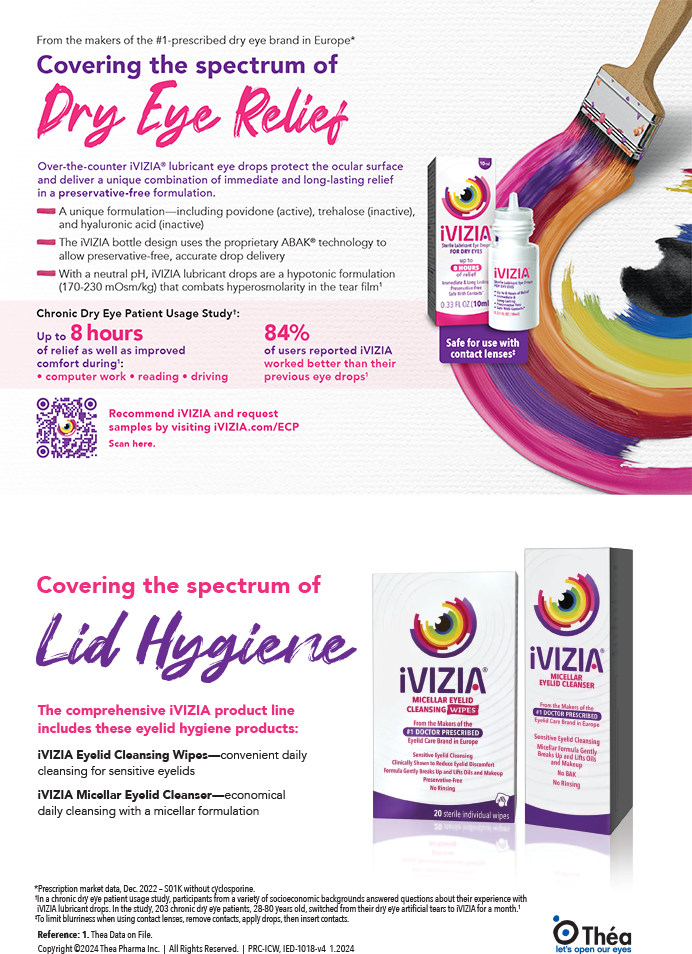
Cataract extraction is one of the most common surgeries performed in the United States, and also one of the safest and most effective. In patients with uveitis, however, this usually routine surgery comes with significantly increased risks.
Uveitis is a group of ocular inflammatory disorders that vary in their association with systemic autoimmunity disease, age of onset, and ocular tissues affected. Although there is a broad swath of potential causes, it is commonly associated with trauma, infection, or autoimmune disease. A condition that is surprisingly common, it has been estimated that the prevalence of uveitis in the United States is almost three times greater than previously thought and that its incidence appears to increase as the population ages.1
As a result of chronic intraocular inflammation, corticosteroid use, or a combination of both factors, cataract is a frequent complication of uveitis. If not carefully managed, uveitic patients who undergo cataract surgery are at risk of extreme postoperative inflammation. This inflammation could lead to the need for additional surgeries—or worse, including significant permanent vision loss and even blindness. It is imperative that surgeons take appropriate pre-, peri-, and postoperative precautions to limit these risks and optimize the chances for a successful outcome.
ESTABLISHING THE ETIOLOGY
Deciphering the underlying cause of uveitis before proceeding with cataract surgery is a critical step that should not be neglected. There is a considerable likelihood that the cause could have an impact on the patient’s systemic health. In my experience, a majority of uveitic patients have a related systemic disease.
Outcomes of cataract surgery are better in some types of uveitis than others. For example, patients with Fuchs heterochromic iridocyclitis, now known as Fuchs uveitis syndrome, fare far better generally than those with uveitis related to Behcet disease or posterior uveitis.2 Therefore, establishing the cause will help identify patients who will gain from cataract surgery versus those for whom the risks may outweigh the benefits. If the surgeon is unable to identify the underlying cause through a relevant history, detailed ophthalmic and systemic evaluation, and review of medical systems along with laboratory testing, the patient should be referred to a uveitis specialist or rheumatologist.
A complete ophthalmic examination will also identify potential associated conditions, including glaucoma, synechiae, cystoid macular edema, retinal neovascularization, optic atrophy, and macular scarring. Any condition diagnosed preoperatively can then be treated appropriately and thereby improve the predicted outcome of surgery by preparing for associated complications.
ELIMINATING INFLAMMATION
Once a cause is established, the astute clinician identifies a targeted treatment regimen that will adequately address significant issues. The rule of thumb for the preoperative management of uveitis should be “zero tolerance.” That is, the goal is not simply to bring the inflammation under control, but to eliminate it: zero cells, zero flare, no keratic precipitates, no cystoid macular edema, and no punctate keratopathy. In adults, the eye must be absolutely quiet for at least 3 months prior to cataract surgery. In children, it should be controlled for at least 6 months before surgery. Furthermore, maintenance steroid therapy should be increased 1 week prior to surgery to prepare the eye for the inevitable inflammatory avalanche created by even the most careful, uncomplicated surgery.
Corticosteroids— administered topically, locally, or systemically—are an effective option, but side effects from their long-term use must be considered.3 Disease-modifying antirheumatic drugs including cyclosporine, methotrexate, mycophenolate, and tumor necrosis factor inhibitors may also be useful. These medications provide an essential steroid-sparing strategy when inflammation is not controlled after 1 month of high-dose corticosteroids, control of inflammation requires more than 7.5 mg of steroid daily, or side effects develop that require the stopping or tapering of steroids.4
SELECTING AN APPROPRIATE IOL
In the past, surgeons often left uveitic patients aphakic to avoid postoperative complications associated with previously available IOLs. Thanks to advances in technology and implant design, most adults with uveitis can have an IOL successfully implanted, as long as careful consideration is given to selecting a lens based on its material, design, and properties.
Generally, multifocal and accommodating lenses are not appropriate choices in the setting of chronic uveitis, because future episodes of inflammation may compromise visual potential, capsular flexibility, media clarity, and zonular fibers. Another reason why multifocal IOLs are typically not recommended is that irregular pupils or IOL decentration, both of which can cause glare and halos, are more common in uveitic eyes.
In uveitic eyes with minimal astigmatism, the Bausch + Lomb enVista IOL is my current lens of choice. The implant is a single-piece hydrophobic acrylic lens with a sharp 360º posterior square edge. It is polished for a smooth optic surface and hydrated and packaged in 0.9% NaCl to prevent fluid exchange and glistenings. The enVista hydrophobic acrylic IOL is the first and only FDA-approved IOL in the United States with labeling that states: “No glistenings of any grade were reported for any subject at any visit in the clinical study” (data on file with Bausch + Lomb). The lens is also designed to minimize posterior capsular opacification, a common complication of cataract surgery in uveitic eyes.5
Recently, I conducted a study designed to assess clinical outcomes in patients with cataract and concomitant intraocular inflammatory conditions after phacoemulsification and implantation of the enVista. The study was a retrospective series of 50 eyes with cataract and concomitant ocular inflammatory conditions, including uveitis, keratitis, or previous ocular trauma who underwent phacoemulsification and implantation of the enVista IOL. All surgeries were performed by a single surgeon using the Bausch + Lomb Injector System, which was designed for use with this lens.
Patients were observed for 3 months. Outcomes evaluated included postoperative BCVA, anterior chamber cells, and IOL deposits. BCVA at postoperative month 3 was 20/50 or better in 98% of eyes and 20/25 or better in 76% of eyes. Manifest refraction spherical equivalent was within ±1.00 D of target in 100% of eyes and within ±0.50 D of target in 88% of eyes. No IOL inflammatory deposits or glistenings were observed. IOL insertion was uncomplicated, and no wound leaks were noted.
Based on this clinical experience with the enVista IOL, my colleagues and I concluded that this technology is appropriate for cataract patients at increased risk of intraocular inflammation.
PERIOPERATIVE CONSIDERATIONS
The management of perioperative inflammation is paramount in uveitic patients. The appropriate use of perioperative steroids should be considered.
Excellent IOL positioning in the bag is necessary to avoid IOL decentration, as such a complication could be much more devastating in these patients, potentially leading to IOL tilt, iris capture, or recalcitrant anterior segment inflammation. The capsulorhexis must therefore completely overlap the optic. Although complete cortical removal and thorough irrigation for debris removal are always critical, meticulous work is essential in these cases.
Pupil management is a common concern. Effective options include the use of a Malyugin Ring (Microsurgical Technology), iris retractors, intracameral Shugarcaine, or Omidria (intracameral phenylephrine and ketorolac; Omeros [approved by the FDA in 2014 to prevent miosis, offers the added indication of pain management postoperatively]).
Uveitic patients may also benefit from laser cataract surgery. When one creates the central cylinder in the cataractous lens using this technology, one effectively reduce the amount of energy required to accomplish phacoemulsification, thus offering another distinct advantage in the form of protecting the integrity of the corneal endothelium.6-8
POSTOPERATIVE MONITORING
Patients with uveitis need to be monitored very closely, as they are at increased risk for a variety of postoperative complications, including persistent inflammation, posterior capsular opacification, IOL deposits and decentration, anterior synechiae, posterior synechiae, glaucoma, and macular edema. Postoperative prednisone should be considered. More frequent follow-up appointments should be scheduled to ensure that inflammation is controlled and any potential complications are detected early and managed aggressively.
In addition to the clinical evaluations conducted at follow-up appointments, each visit provides an opportunity to encourage therapeutic compliance, which may benefit these patients in particular. So many patients suffering from uveitis find it difficult to keep up with the plethora of medications and complex regimens that have necessarily been prescribed.
1. Gritz DC, Wong IG. Incidence and prevalence of uveitis in Northern California: The Northern California Epidemiology of Uveitis Study. Ophthalmology. 2004;111(3):491-500 .
2. Mehta S, Linton MM, Kempen JH. Outcomes of cataract surgery in patients with uveitis: a systematic review and meta-analysis. Am J Ophthalmol. 2014;158(4):676-692.e7.
3. Baheti U, Siddique SS, Foster CS. Cataract surgery in patients with a history of uveitis. Saudi J Ophthalmol. 2012;26(1):55-60.
4. Jabs DA, Rosenbaum JT. Guidelines for the use of immunosuppressive drugs in patients with ocular inflammatory disorders: recommendation of an expert panel. Am J Ophthalmol. 2001;131(5):679.5.
5. Nishi O, Nishi K, Okasabe Y. Effect of intraocular lenses on preventing. J Cataract Refract Surg. 2004;30(10):2170-2176.
6. Conrad-Hengerer I, Hengerer FH, Schultz T, Dick HB. Effect of femtosecond laser fragmentation on effective phacoemulsification time in cataract surgery. J Refract Surg. 2012;28(12):879-883.
7. Reddy KP1, Kandulla J, Auffarth GU. Effectiveness and safety of femtosecond laser-assisted lens fragmentation and anterior capsulotomy versus the manual technique in cataract surgery. J Cataract Refract Surg. 2013;39(9):1297-1306.
8. Abell RG, Kerr NM, Vote BJ. Femtosecond laser-assisted cataract surgery compared with conventional cataract surgery. Experiment Ophthalmol. 2013;41(5):455-462.
John D. Sheppard, MD, MMSc
• professor of ophthalmology, microbiology & immunology, clinical
director of the Thomas R. Lee Center for Ocular Pharmacology,
and ophthalmology residency research director at the Eastern
Virginia Medical School in Norfolk, Virginia
• president of Virginia Eye Consultants and the medical director of
the Lions Eye Bank of Eastern Virginia
• (757) 622-2200; docshep@hotmail.com.
• financial disclosure: consultant to Bausch + Lomb


